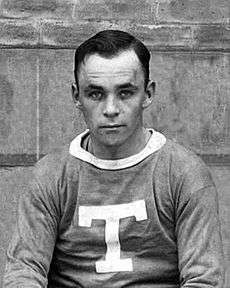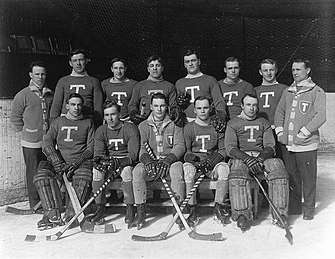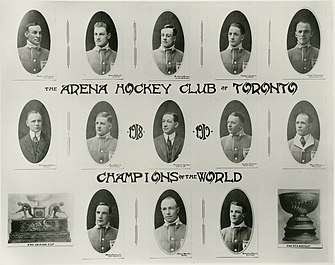Harry Cameron
Harold Hugh Cameron (February 6, 1890 – October 20, 1953) was a Canadian ice hockey defenceman who played professionally for the Toronto Blueshirts, Toronto Arenas, Ottawa Senators, Toronto St. Pats and Montreal Canadiens. Cameron won three Stanley Cups in his career: his first as a member of the 1913–14 Toronto Blueshirts, his second as a member of the 1917–18 Blueshirts (Arenas) and his third as a member of the 1921–22 Toronto St. Pats (all predecessor clubs of the Toronto Maple Leafs).
| Harry Cameron | |||
|---|---|---|---|
| Hockey Hall of Fame, 1963 | |||
 | |||
| Born |
February 6, 1890 Pembroke, Ontario, Canada | ||
| Died |
October 20, 1953 (aged 63) Vancouver, British Columbia, Canada | ||
| Height | 5 ft 10 in (178 cm) | ||
| Weight | 155 lb (70 kg; 11 st 1 lb) | ||
| Position | Defence | ||
| Shot | Right | ||
| Played for |
Toronto Blueshirts Toronto Arenas Ottawa Senators Montreal Canadiens Toronto St. Patricks Saskatoon Sheiks Minneapolis Millers St. Louis Flyers | ||
| Playing career | 1912–1933 | ||
Cameron was considered one of the first great rushing and scoring defencemen.[1] He scored 88 goals in 121 games in the NHL. He was also famous for his "curved shot" similar to that of today's curved hockey sticks.[1] Cameron was the first player in NHL history to achieve what was later called a "Gordie Howe hat trick", doing so on December 26, 1917 during a 7-5 defeat of the Montreal Canadiens.[2] In later years, he moved to Vancouver, British Columbia where he resided when he died in 1953.[1] He was inducted posthumously into the Hockey Hall of Fame in 1963.[3]
Playing career

Born in Pembroke, Ontario Cameron played with the Pembroke Debaters club from 1908 until 1911, before becoming a professional with the Port Arthur Lake City of the Northern Ontario Hockey League (NOHL). The transaction is also famous as he demanded that his friend Frank Nighbor also be signed.[1] While playing with Nighbor in the Upper Ottawa Valley Hockey League (UOVHL) during the 1910–11 season Pembroke Debaters won the Citizen Shield after having defeated Vankleek Hill 10 goals to 8.[4] The 1911–12 Port Arthur team also featured future Hockey Hall of Fame member Jack Walker.
Cameron (along with Nighbor) joined the Toronto Blueshirts of the National Hockey Association (NHA) for the 1912–13 season and stayed with the organization until the NHA suspended the franchise in the 1916–17 season, including the 1914 Stanley Cup win. He was picked up by the Montreal Wanderers for the balance of the season, playing six games for the Redbands. In 1917–18 he returned to the Blueshirts, now a franchise in the National Hockey League (NHL), operated by the Toronto Arena Company in their Stanley Cup-winning season. Cameron was the highest paid player on the 1917–18 Toronto Arenas with a salary of $900, whereas his teammates salaries ranged from $450 to $750.[5]
In 1918–19, he was loaned to the Ottawa Senators and returned from the Senators in the 1919–20 season to the Toronto team, now named the Toronto St. Pats (St. Patricks). He was traded to the Montreal Canadiens in January 1920 (for Goldie Prodgers[6]), but returned to Toronto in the following fall when he was traded back to the club (again for Prodgers, and Joe Matte). The 1920–21 through 1922–23 seasons saw Cameron stay with the St. Pats, winning another Stanley Cup in 1922, the third for Toronto in the NHA and NHL.
After the Stanley Cup win, Cameron was released, and he played three seasons as a playing coach for the Saskatoon Crescents of the Western Canada Hockey League (WCHL) where he switched to forward. After the Western League was folded and its players absorbed in the NHL, Cameron was not picked up, and he joined a succession of minor league teams in Saskatoon, Minneapolis and St. Louis before retiring in 1931. He joined the Saskatoon team in 1932–33, playing nine games. He left the playing side of the game for good, and became the Saskatoon coach from 1934 through 1937.
Playing style
The Toronto World describing Cameron in a game between the Ottawa Senators and the Toronto St. Patricks in Ottawa on March 10, 1921.[7]
Harry Cameron was a strong puck carrying defenseman who could electrify the crowd with his speedy rushes up the ice,[8] end-to-end rushes which also made him a viable goal scoring threat in the face of the opposing teams, as he was also a crafty stickhandler.[9] During his first two seasons in the NHA with the Toronto Blueshirts Cameron made a strong defensive pairing with Jack Marshall, and even though Cameron was only of average height (5 ft 10 in) and weight (155 lb) he could still use his body on the defensive side of the puck to stop oncoming opponents.[10] Later on, with the Toronto Arenas, he would pair with big-bodied defenseman Harry Mummery (220 lb). In the NHL Cameron had among his defensive partners Sprague Cleghorn (Ottawa Senators and Toronto St. Patricks) and Red Stuart (Toronto St. Patricks).
Curved shot
The Montreal Gazette describing Cameron scoring a goal on Georges Vezina in a game between the Toronto St. Patricks and the Montreal Canadiens in Toronto on December 26, 1920.[11]
Cameron had also a hard shot which landed him many goals throughout his hockey career, and he was one of the few players at the time who could curve his shot. Long time New York Rangers right winger Bill Cook, a teammate of Cameron with the Saskatoon Crescents of the WCHL and the WHL from 1923–1926, claimed Cameron could shoot curving pucks. Left winger Cy Denneny, a teammate of Cameron on the 1915–16 Toronto Blueshirts and the 1918–19 Ottawa Senators, was another player who could do the same trick, but both Cameron and Denneny employed specially scooped sticks for the deed. The players on the 1930–31 New York Rangers (including Cook, Leo Bourgeault, Frank Boucher, Murray Murdoch, John Ross Roach and Eddie Rodden), in a newspaper interview with Harold C. Burr of The Brooklyn Daily Eagle, agreed that there were no one in the National Hockey League at that time who could fire off a curved vulcanized rubber disk in the same type of fashion.[12] Cameron for the 1930–31 season had taken his hockey playing services to the St. Louis Flyers of the AHA.
Although hockey sticks at the time were made almost exclusively with straight blades, Frank Boucher once claimed that Cameron played with a stick that was "crooked like a sabre", which allowed him to make his shots drop or veer to either side.[13] Nevertheless, a small handful of contemporary players like Gordie Roberts were able to curve the path of pucks simply by wrist action, and modern historians speculate that Cameron had this ability as well.[1]
Career statistics


Regular season and playoffs
| Regular season | Playoffs | |||||||||||||
|---|---|---|---|---|---|---|---|---|---|---|---|---|---|---|
| Season | Team | League | GP | G | A | Pts | PIM | GP | G | A | Pts | PIM | ||
| 1908–09 | Pembroke Debaters | UOVHL | 6 | 13 | 0 | 13 | — | — | — | — | — | — | ||
| 1909–10 | Pembroke Debaters | UOVHL | 8 | 17 | 0 | 17 | — | — | — | — | — | — | ||
| 1910–11 | Pembroke Debaters | UOVHL | 6 | 9 | 1 | 10 | 8 | 2 | 4 | 4 | 8 | 0 | ||
| 1911–12 | Port Arthur Lake City | NOHL | 15 | 6 | 0 | 6 | 48 | 2 | 2 | 0 | 2 | 0 | ||
| 1912–13 | Toronto Blueshirts | NHA | 20 | 9 | 0 | 9 | 20 | — | — | — | — | — | ||
| 1913–14 | Toronto Blueshirts | NHA | 19 | 15 | 4 | 19 | 22 | 2 | 0 | 2 | 2 | 6 | ||
| 1913–14 | Toronto Blueshirts | St-Cup | — | — | — | — | — | 3 | 1 | 0 | 1 | 4 | ||
| 1914–15 | Toronto Blueshirts | NHA | 17 | 12 | 8 | 20 | 43 | — | — | — | — | — | ||
| 1915–16 | Toronto Blueshirts | NHA | 24 | 8 | 3 | 11 | 70 | — | — | — | — | — | ||
| 1916–17 | Toronto Blueshirts | NHA | 14 | 8 | 4 | 12 | 20 | — | — | — | — | — | ||
| 1916–17 | Montreal Wanderers | NHA | 6 | 1 | 1 | 2 | 9 | — | — | — | — | — | ||
| 1917–18 | Toronto Arenas | NHL | 21 | 17 | 10 | 27 | 28 | 2 | 1 | 2 | 3 | 0 | ||
| 1917–18 | Toronto Arenas | St-Cup | — | — | — | — | — | 5 | 3 | 1 | 4 | 12 | ||
| 1918–19 | Toronto Arenas | NHL | 7 | 6 | 2 | 8 | 9 | — | — | — | — | — | ||
| 1918–19 | Ottawa Senators | NHL | 7 | 5 | 1 | 6 | 26 | 5 | 4 | 0 | 4 | 26 | ||
| 1919–20 | Toronto St. Patricks | NHL | 7 | 3 | 0 | 3 | 6 | — | — | — | — | — | ||
| 1919–20 | Montreal Canadiens | NHL | 16 | 12 | 5 | 17 | 36 | — | — | — | — | — | ||
| 1920–21 | Toronto St. Patricks | NHL | 24 | 18 | 9 | 27 | 35 | 2 | 0 | 0 | 0 | 2 | ||
| 1921–22 | Toronto St. Patricks | NHL | 24 | 18 | 17 | 35 | 22 | 2 | 0 | 2 | 2 | 8 | ||
| 1921–22 | Toronto St. Patricks | St-Cup | — | — | — | — | — | 4 | 0 | 2 | 2 | 14 | ||
| 1922–23 | Toronto St. Patricks | NHL | 22 | 9 | 7 | 16 | 27 | — | — | — | — | — | ||
| 1923–24 | Saskatoon Crescents | WCHL | 29 | 10 | 10 | 20 | 16 | — | — | — | — | — | ||
| 1924–25 | Saskatoon Crescents | WCHL | 28 | 13 | 7 | 20 | 21 | 2 | 1 | 0 | 1 | 0 | ||
| 1925–26 | Saskatoon Crescents | WHL | 30 | 9 | 3 | 12 | 12 | 2 | 0 | 0 | 0 | 0 | ||
| 1926–27 | Saskatoon Sheiks | PHL | 31 | 26 | 19 | 45 | 20 | 4 | 1 | 0 | 1 | 4 | ||
| 1927–28 | Minneapolis Millers | AHA | 19 | 2 | 3 | 5 | 32 | — | — | — | — | — | ||
| 1928–29 | St. Louis Flyers | AHA | 34 | 14 | 3 | 17 | 30 | — | — | — | — | — | ||
| 1929–30 | St. Louis Flyers | AHA | 46 | 14 | 6 | 20 | 34 | — | — | — | — | — | ||
| 1930–31 | St. Louis Flyers | AHA | 37 | 4 | 3 | 7 | 30 | — | — | — | — | — | ||
| 1932–33 | Saskatoon Crescents | WCHL | 9 | 0 | 0 | 0 | 4 | — | — | — | — | — | ||
| NHA totals | 100 | 53 | 20 | 73 | 184 | 2 | 0 | 2 | 2 | 6 | ||||
| WCHL/WHL totals | 87 | 32 | 20 | 52 | 49 | 4 | 1 | 0 | 1 | 4 | ||||
| St-Cup totals | — | — | — | — | — | 12 | 4 | 3 | 7 | 30 | ||||
| NHL totals | 128 | 88 | 51 | 139 | 189 | 11 | 5 | 4 | 9 | 16 | ||||
Awards and achievements
- Stanley Cup – 1914 (with Toronto Blueshirts), 1918 (with Toronto Arenas) and 1922 (with Toronto St. Patricks)
- Added into the Hockey Hall of Fame in 1963.
References
- Hockey Hall of Fame (2003). Honoured Members: Hockey Hall of Fame. Bolton, Ontario: Fenn Publishing. ISBN 1-55168-239-7.CS1 maint: ref=harv (link)
- Podnieks, Andrew (2003). Players: the ultimate A-Z guide of everyone who has ever played in the NHL. Toronto, Ontario: Doubleday Canada. ISBN 0-385-25999-9.
Notes
- Podnieks, p. 119
- Shea, Kevin; Wilson, Jason (2016). The Toronto Maple Leaf Hockey Club: Official Centennial Publication. McClelland & Stewart. ISBN 9780771079290.
- Hockey Hall of Fame 2003.
- "Pembroke team carried off Citizen Shield and the Ottawa Valley Hockey Honors" Ottawa Citizen. 1911-03-02. Retrieved 2018-11-23.
- "Comparison of hockey expenses" Pittsburgh Post-Gazette. 1929-12-23. Retrieved 2018-12-23
- Harry Cameron (Transactions) hockey-reference.com
- "Ottawa Senators blank St. Patricks", The Toronto World. 1921-03-11. Retrieved 2018-11-23.
- "Torontos takes fall from Canadiens by two goals" ("The players") The Toronto World. 1913-02-13. Retrieved 2018-12-23.
- "Saints in first position; down the Senators" ("Cameron a Star") The Toronto World. 1921-02-17. Retrieved 2018-12-23.
- "Torontos show dazzling speed – hand Ontarios good beating" ("Some Good Team Play") The Toronto World. 1914-01-08. Retrieved 2018-11-23.
- "St. Pats came from behind to beat Canadiens", The Montreal Gazette. 1920-12-27. Retrieved 2018-11-23.
- "Rangers' new sticks for Quaker contest selected with care" ("Not many curve shots in league") Harold C. Burr, The Brooklyn Daily Eagle. 1930-11-29. Retrieved 2018-11-23.
- Montreal Gazette – February 3, 1943
External links
- Biographical information and career statistics from Eliteprospects.com, or Hockey-Reference.com, or Legends of Hockey, or The Internet Hockey Database